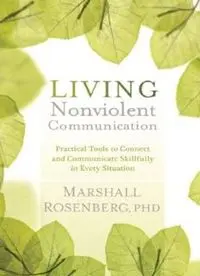
Living nonviolent communication : practical tools to connect and communicate skillfully in every PDF
Preview Living nonviolent communication : practical tools to connect and communicate skillfully in every
LIVING Nonviolent Communication Practical Tools to Connect and Communicate Skillfully in Every Situation MARSHALL ROSENBERG, PhD CONTENTS A Brief Introduction to Nonviolent Communication 1 WE CAN WORK IT OUT Resolving Conflicts Peacefully and Powerfully 2 BEING ME, LOVING YOU A Practical Guide to Extraordinary Relationships 3 GETTING PAST THE PAIN BETWEEN US Healing and Reconciliation without Compromise 4 THE SURPRISING PURPOSE OF ANGER Beyond Anger Management—Finding the Gift 5 RAISING CHILDREN COMPASSIONATELY Parenting the Nonviolent Communication Way 6 PRACTICAL SPIRITUALITY Reflections on the Spiritual Basis of Nonviolent Communication RECOMMENDED READING ABOUT THE CENTER FOR NONVIOLENT COMMUNICATION ABOUT THE AUTHOR ADDITIONAL PRAISE FOR MARSHALL ROSENBERG, PHD “We should all be grateful to Marshall Rosenberg. He provides us with the most effective tools to foster health and relationships. Nonviolent Communication connects soul to soul, creating a lot of healing and helps us express honestly from the heart what are people doing that is or is not in harmony with our needs. NVC is the missing element in what we do.” —Deepak Chopra, author of Ageless Body, Timeless Mind “Dr. Rosenberg has brought the simplicity of successful communication into the foreground. No matter what issue you’re facing, his strategies for communicating with others will set you up to win every time.” —Anthony Robbins, author of Awaken the Giant Within and Unlimited Power “Written with a profound level of clarity and compassion known only to those who practice what they preach, Marshall’s Living Nonviolent Communication opens us to give our heart’s willing consent to communicate in ways that foster authentic trust and intimate connection both with ourselves and in all forms of relationship.” —Michael Bernard Beckwith, author of Life Visioning: A Transformative Process for Activating Your Unique Gifts and Highest Potential A BRIEF INTRODUCTION TO NONVIOLENT COMMUNICATION Nonviolent Communication, or NVC, is a powerful model of communication, but it goes far beyond that. It is a way of being, thinking, and living in the world. Its purpose is to inspire heartfelt connections between ourselves and other people —connections that allow everyone’s needs to be met through compassionate giving. It inspires us and others to give from the heart. It also helps us connect to our inner divinity and to what is alive in us moment to moment. We could say that NVC is a language of compassion, but it is really a language of life in which compassion comes naturally. The model shows us how to express what is alive in us and to see what is alive in other people. Once we get clear about what is alive in us, we can look at what we can do to enrich that life. Nonviolent Communication evolved out of an intense interest I had in two questions. First, I wanted to better understand what happens to human beings that leads some of us to behave violently and exploitatively. And second, I wanted to better understand what kind of education serves our attempts to remain compassionate—which I believe is our nature— even when others are behaving violently or exploitatively. The theory that has been around for many centuries says that violence and exploitation happen because people are innately evil, selfish, or violent. But I have seen people who aren’t like that; I have seen many people who enjoy contributing to one another’s well-being. So, I wondered why some people seem to enjoy other people’s suffering, while other people are just the opposite. Some Basic Feelings We All Have Feelings When Needs Feelings When Needs Are Fulfilled Are Not Fulfilled Amazed Angry Comfortable Annoyed Confident Concerned Eager Confused Energetic Disappointed Fulfilled Discouraged Glad Distressed Hopeful Embarrassed Inspired Frustrated Intrigued Helpless Joyous Hopeless Moved Impatient Optimistic Irritated Proud Lonely Relieved Nervous Stimulated Overwhelmed Surprised Puzzled Thankful Reluctant Touched Sad Trustful Uncomfortable In my exploration of these two questions, I found that the following three factors are very important in understanding why some of us respond violently and some of us respond compassionately in similar situations: • The language that we have been educated to use • How we have been taught to think and communicate • The specific strategies we have learned to influence others and ourselves Some Basic Needs We All Have Autonomy Choosing one’s dreams, goals, Choosing one’s plan for fulfilling and values thoses dreams, goals, and values Celebration Celebrating the creation of life Celebrating losses of loved ones, and dreams fulfilled dreams, and so on (mourning) Integrity
